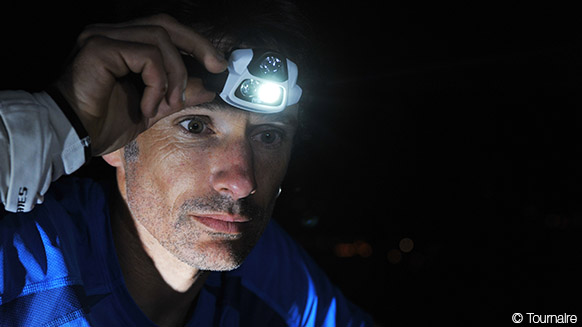Running at night: tips from the pros
With the fall season almost upon us after the major 2016 Ultra Trails of August, now is a great time for a quick review on headlamp use and the right approach to running at night. By Fred Bousseau – Trails Endurance Mag
August 31 2016
Running
Running at night has become increasingly common with the rapid growth in trail ultramarathons, which often involve racing around the clock (or even spending 2 nights outdoors), not to mention the limited amount of daylight during the winter season for those who compete all year long. Running at night is not something to improvise the day of and requires preparation. Only through experience do trail runners acquire the right technique and become well-versed with their gear.
Here is a detailed breakdown of running at night, including a few select tips from the pros.
Running safe and with confidence

The headlamp has evolved into a piece of safety equipment that runners should always carry in their packs right alongside their survival blanket and mobile phone…You just never know what will happen out on the trail. However, nighttime can also be a powerful ally. All runners should think about and prepare for a change strategy, pace, and visibility; the dark is often a source of stress and cause for losing your composure. It is important to prepare and train in the same conditions you will likely encounter the day of the race.
3 tips for training to run at night
All expert athletes agree that you have to train at night, and for several reasons.
- The first is familiarizing your eyes, peripheral vision, ground feel, and the all-important (but often neglected) mental aspect of running at night when training. Being alone in the dark is not necessarily natural for everyone and often creates a certain amount of anxiety and stress that you need to understand and manage. In return, as Sébastien Chaigneau and Nathalie Mauclair like to highlight, you will have the opportunity to enjoy a completely different experience (freedom, a more heightened sense of adventure, total silence, nocturnal animal sounds and encounters…).
- For the second tip, Maud Gobert recommends forcing yourself to train in bad weather, in either rain or snow (not always the most enjoyable experience) to learn how both posture and frame of reference change in adverse conditions. The tendency will be to lower your head to fight against the elements, reducing your peripheral vision and requiring you to pay closer attention to course markings. Training in the fog, however dense and even for a short period of time, can help to hone additional skills and avoid any unpleasant surprises. Fog often makes for a tricky situation, and if you already have experience running through the fog you will be better equipped to handle the challenge, or at least to avoid any unnecessary anxiety. Running in the fog can often cause dizziness or even headaches due to fatigue coupled with losing sight of most landmarks.
- Finally, training at night allows you to test and become intimately familiar with your gear. Race day is definitely not the right moment to turn your headlamp on for the first time! Test each lighting mode, adjust the strap for the right fit, and learn how to use each button…
Tips and tricks from the pros
Running at night requires training and experience, so to help you prepare and run faster on race day, three runners from Team Petzl each offer their ONE tip to follow.
Nathalie Mauclair (winner, 2015 UTMB):
"Don't overlook this aspect of trail running and really force yourself to train with your nighttime gear to test your headlamp, and to fine-tune your pace and stride."
Sébastien Chaigneau (winner, Hard Rock 100):
"When you begin running at night, the best thing to do is to start with a group of 3 or 4 friends on trails that you have already run during the day. This is more fun and you'll cover familiar terrain. It will be then much easier to run alone on increasingly longer outings."
Maud Gobert (2011 World Champion):
"If you're worried about training at night, then try heading out 30 minutes to 1 hour before daybreak to remove any anxiety about running in the dark. Not only will you get to see the sunrise, but it is also a great way to start your day."
"To avoid any unpleasant surprises, remember to lock the ON/OFF button when the headlamp is in your pack. This way you won't run the risk of your headlamp accidentally switching on, leaving you with a dead battery and no light when you reach into your pack."
The right gear
Petzl offers several lighting solutions for trail running. The most well-known models are the NAO and TIKKA RXP, both equipped with the high-performance automatic REACTIVE LIGHTING system, which can be compared to the headlights / high beams on your car.
These headlamps offer the option of using interchangeable batteries and batteries you can carry in your pack (especially in cold weather).
Two new connected models enhance the range, the NAO+ (available in November 2016) and the REACTIK+. You can program them through your mobile phone using a Bluetooth connection to set, for example, brightness levels or burn times.
For a headlamp to perform properly, charge the battery until the very last minute and then test the battery just before leaving to verify that it is well charged. During the race, remember that it is much colder at night and that cold temperatures affect battery life.
So light up the trails, happy racing, and most importantly enjoy running at night!
Related News







